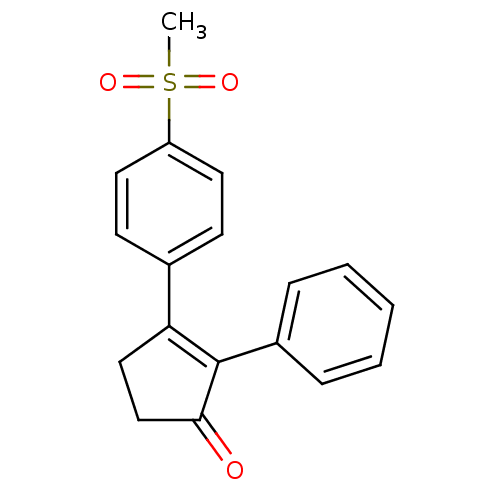BDBM50075662 3-(4-Methanesulfonyl-phenyl)-2-phenyl-cyclopent-2-enone::CHEMBL23170
SMILES CS(=O)(=O)c1ccc(cc1)C1=C(C(=O)CC1)c1ccccc1
InChI Key InChIKey=UNHXJQNYRJHGEJ-UHFFFAOYSA-N
Data 4 IC50
Activity Spreadsheet -- Enzyme Inhibition Constant Data from BindingDB
 Found 4 hits for monomerid = 50075662
Found 4 hits for monomerid = 50075662
TargetProstaglandin G/H synthase 2(Human)
Merck Frosst Centre For Therapeutic Research
Curated by ChEMBL
Merck Frosst Centre For Therapeutic Research
Curated by ChEMBL
Affinity DataIC50: 11nMAssay Description:In vitro potency against human Prostaglandin G/H synthase 2 in transfected CHO cells.More data for this Ligand-Target Pair
TargetProstaglandin G/H synthase 2(Human)
Merck Frosst Centre For Therapeutic Research
Curated by ChEMBL
Merck Frosst Centre For Therapeutic Research
Curated by ChEMBL
Affinity DataIC50: 190nMAssay Description:In vitro potency against human Prostaglandin G/H synthase 2 in the human whole blood assay.More data for this Ligand-Target Pair
TargetProstaglandin G/H synthase 1(Human)
Merck Frosst Centre For Therapeutic Research
Curated by ChEMBL
Merck Frosst Centre For Therapeutic Research
Curated by ChEMBL
Affinity DataIC50: 3.10E+3nMAssay Description:In vitro potency against human Prostaglandin G/H synthase 1 in U937 microsomes. More data for this Ligand-Target Pair
TargetProstaglandin G/H synthase 1(Human)
Merck Frosst Centre For Therapeutic Research
Curated by ChEMBL
Merck Frosst Centre For Therapeutic Research
Curated by ChEMBL
Affinity DataIC50: 4.10E+3nMAssay Description:In vitro potency against human Prostaglandin G/H synthase 1 (hCOX-1) in the human whole blood assay.More data for this Ligand-Target Pair
